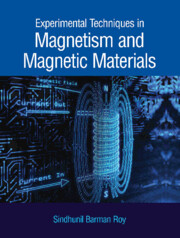Book contents
- Frontmatter
- Dedication
- Contents
- Preface
- I Introduction to Magnetism and Magnetic Materials
- II Basic Phenomenology of Magnetism
- III Experimental Techniques in Magnetism
- Appendix A Magnetic Fields and Their Generation
- Appendix B Units in Magnetism
- Appendix C Demagnetization Field and Demagnetization Factor
- Index
9 - Neutron Scattering
Published online by Cambridge University Press: 27 October 2022
- Frontmatter
- Dedication
- Contents
- Preface
- I Introduction to Magnetism and Magnetic Materials
- II Basic Phenomenology of Magnetism
- III Experimental Techniques in Magnetism
- Appendix A Magnetic Fields and Their Generation
- Appendix B Units in Magnetism
- Appendix C Demagnetization Field and Demagnetization Factor
- Index
Summary
A neutron is a nuclear particle, and it does not exist naturally in free form. Outside the nucleus, it decays into a proton, an electron, and an anti-neutrino. The scattering of low energy neutrons in solids forms the basis of a very powerful experimental technique for studying material properties. A neutron has a mass mn= 1.675 × 10−27 kg, which is close to that of the proton and a lifetime τ = 881.5 ±1.5 s. This lifetime is considerably longer than the time involved in a typical scattering experiment, which is expected to be hardly a fraction of a second.
A neutron has several special characteristics, which makes it an interesting tool for studying magnetic materials as well as engineering materials and biological systems. It is an electrically neutral, spin-1/2 particle that carries a magnetic dipole moment of μ = -1.913 μN, where nuclear magneton μN = eh/mp = 5.051 ×10−27 J/T. The zero charge of neutron implies that its interactions with matter are restricted to the short-ranged nuclear and magnetic interactions. This leads to the following important consequences:
1. The interaction probability is small, and hence the neutron can usually penetrate the bulk of a solid material.
2. Additionally, a neutron interacts through its magnetic moment with the electronic moments present in a magnetic material strong enough to get scattered measurably but without disturbing the magnetic system drastically. This magnetic neutron scattering has its origin in the interaction of the neutron spin with the unpaired electrons in the sample either through the spin of the electron or through the orbital motion of the electron. Thus, the magnetic scattering of neutrons in a solid can provide the most direct information on the arrangement of magnetic moments in a magnetic solid.
3. Energy and wavelength of a neutron matches with electronic, magnetic, and phonon excitations in materials and hence provide direct information on these excitations.
Neutrons behave predominantly as particles in neutron scattering experiments before the scattering events, and as waves when they are scattered. They return to their particle nature when they reach the detectors after the scattering events.
- Type
- Chapter
- Information
- Experimental Techniques in Magnetism and Magnetic Materials , pp. 191 - 236Publisher: Cambridge University PressPrint publication year: 2023



